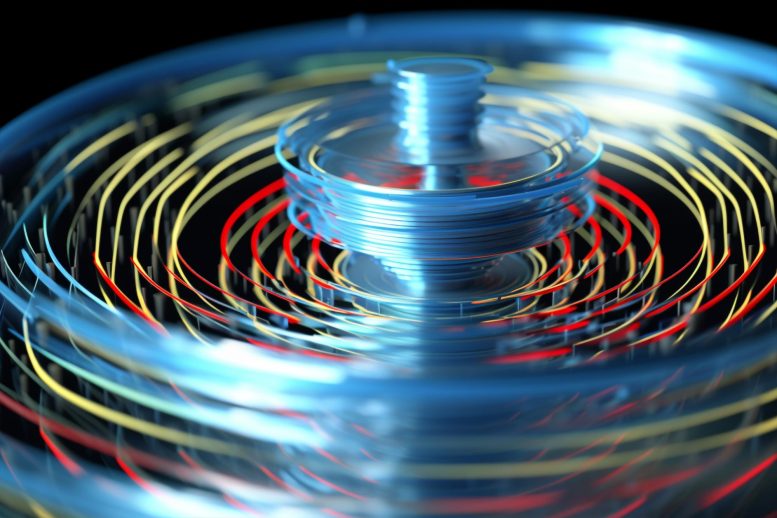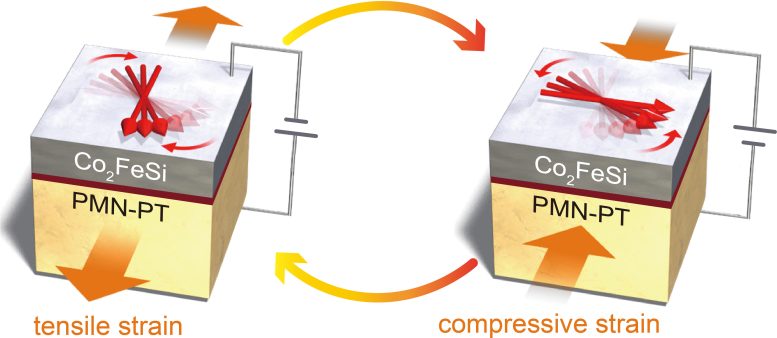
Scientists demonstrate the ability to control the direction of magnetization by applying strain to a multiferroic material at the interface.
Directing magnetization with a low electric field is crucial for advancing effective spintronic devices. In spintronics, the characteristics of an electron’s spin or magnetic moment are leveraged for information storage. By modifying orbital magnetic moments through strain, it’s possible to manipulate electron spins, leading to an enhanced magnetoelectric effect for superior performance.
Japanese researchers, including Jun Okabayashi from the University of Tokyo, revealed a strain-induced orbital control mechanism in interfacial multiferroics. In multiferroic material, the magnetic property can be controlled using an electric field—potentially leading to efficient spintronic devices. The interfacial multiferroics that Okabayashi and his colleagues studied consist of a junction between a ferromagnetic material and a piezoelectric material. The direction of magnetization in the material could be controlled by applying voltage.

Mechanism and Implications for Spintronic Devices
The team showed the microscopic origin of the large magnetoelectric effect in the material. The strain generated from the piezoelectric material could change the orbital magnetic moment of the ferromagnetic material. They revealed element-specific orbital control in the interfacial multiferroic material using reversible strain and provided guidelines for designing materials with a large magnetoelectric effect. The findings will be useful in developing new information writing technology that consumes less power.
Reference: “Strain-induced specific orbital control in a Heusler alloy-based interfacial multiferroics” by Jun Okabayashi, Takamasa Usami, Amran Mahfudh Yatmeidhy, Yuichi Murakami, Yu Shiratsuchi, Ryoichi Nakatani, Yoshihiro Gohda and Kohei Hamaya, 10 January 2024, NPG Asia Materials.
DOI: 10.1038/s41427-023-00524-6
The study was funded by the Japan Society for the Promotion of Science, the Japan Science and Technology Agency, The Spintronics Research Network of Japan, and the Yazaki Memorial Foundation for Science and Technology.
2 Comments
To bad this experiment doesn’t have a wider range of collaboration base. a wide base can minimize the pier review of credibility, this manipulation of spin can reach a much larger application as observations of different materials used.
Please answer:
1. Why spin?
2. Is spin related to the rotation of topological vortices?
3. Why would Contemporary Physics rather use a cat than the rotation of topological vortices to understand and analogize quantum mechanics?
and so on.
Science must follow mathematical rules. For example, the Standard Model (SM) is considered to be one of the most significant achievements of physics in the 20th century. However, the magnetic moment of μ particle is larger than expected, revealed by a g-2 experiment at Fermilab, suggests that the established theory (such as SM) of fundamental particles is incomplete. Furthermore, the SM omitting gravity, it not involved the time problem and when the particle movement starts. Mathematics is the foundation of science. Physics must respect the scientific nature of mathematics and mathematical models. The SM must be based on mathematical models in order to be scientific, convincing, and in line with natural laws.
I hope researchers are not fooled by the pseudoscientific theories of the Physical Review Letters (PRL), and hope more people dare to stand up and fight against rampant pseudoscience.
The so-called academic journals (such as Physical Review Letters, Nature, Science, etc.) firmly believe that two high-dimensional spacetime objects (such as two sets of cobalt-60) rotating in opposite directions can be transformed into two objects that mirror each other, is a typical case of pseudoscience rampant.
If researchers are really interested in Science and Physics, you can browse https://zhuanlan.zhihu.com/p/643404671 and https://zhuanlan.zhihu.com/p/595280873.